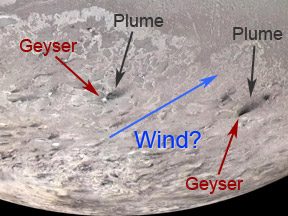This picture shows geysers near Triton's South Pole. The geysers shoot dark material high into Triton's atmosphere. This dark plume settles back down to Triton's surface. Scientists think we can tell which way the wind blows on Triton because of this! Do you see how the geyser plumes point from lower-left towards upper-right in this picture?
Click on image for full size
Image courtesy NASA/JPL/USGS.
The Atmosphere of Triton
Triton is by far the largest moon of Neptune. It is slightly smaller than Earth's Moon. The surface of Triton is colder than the surface of any other planet or moon in our Solar System. It is so cold on Triton that almost everything freezes, even gases. That's why it is surprising that Triton has an atmosphere.
Triton's atmosphere is very, very thin. The air pressure on Earth is more than 50,000 times higher than on the surface of Triton! Most of the air on Triton is the gas nitrogen... just like on Earth! Most of the nitrogen on Triton is frozen. It is on the ground in the form of frost. Some of the nitrogen frost warmed up just a little and evaporated. That's what makes Triton's thin atmosphere.
Triton also has several ice geysers near its South Pole. The geysers shoot nitrogen, dust, and chemicals containing methane high into the atmosphere. Triton has clouds of nitrogen ice particles in the lower parts of its atmosphere. There is also a haze layer made of hydrocarbons which forms when sunlight hits methane molecules in Triton's air.
There are dark areas on the ground near several geysers. Scientists think winds blew the dark materials from the geysers in that direction. So it seems like Triton has winds!
Earth's atmosphere has layers, and so does Triton's. Triton's atmosphere has a troposphere, a thermosphere and an exosphere. It does not have a stratosphere. The top of the atmosphere is about 800 km (500 miles) above Triton's surface.
You might also be interested in:
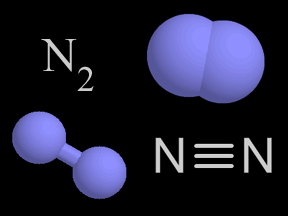
There is more nitrogen gas in the air than any other kind of gas. About 4/5ths of Earth's atmosphere is nitrogen gas! A molecule of nitrogen gas is made up of two nitrogen atoms. There are other molecules
...more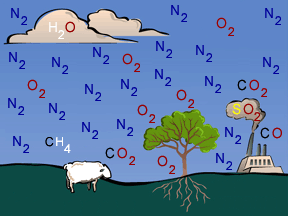
Most of the gas in Earth's atmosphere is nitrogen. About 4/5ths of the air is nitrogen. What about the other 1/5th? Almost all of it is oxygen, the stuff in the air we need to breathe. There are also very
...more
One process which transfers water from the ground back to the atmosphere is evaporation. Evaporation is when water passes from a liquid phase to a gas phase. Rates of evaporation of water depend on things
...more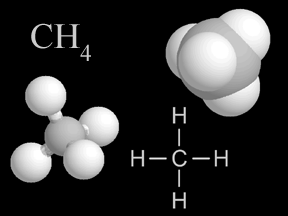
Methane is a kind of gas. There is a small amount of methane in the air you breathe. A methane molecule has carbon and hydrogen atoms in it. Methane is a greenhouse gas. That means it helps make Earth
...more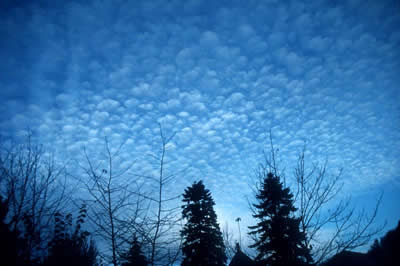
The high cloud group consists of Cirrus, Cirrostratus, and Cirrocumulus clouds. High clouds are made of ice crystals due to the cold air in the upper sky. The base of a high cloud above the surface can
...more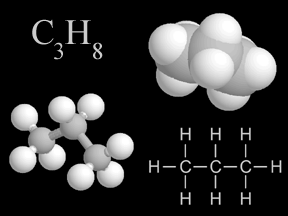
There is a group of chemicals called hydrocarbons. The molecules of hydrocarbons are made of hydrogen and carbon atoms. Most kinds of fuel have hydrocarbons in them. Hydrocarbons store energy. Coal, oil,
...more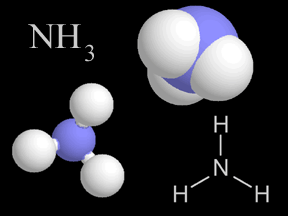
Most things around us are made of groups of atoms bonded together into packages called molecules. The atoms in a molecule are held together because they share or exchange electrons. Molecules are made
...more


